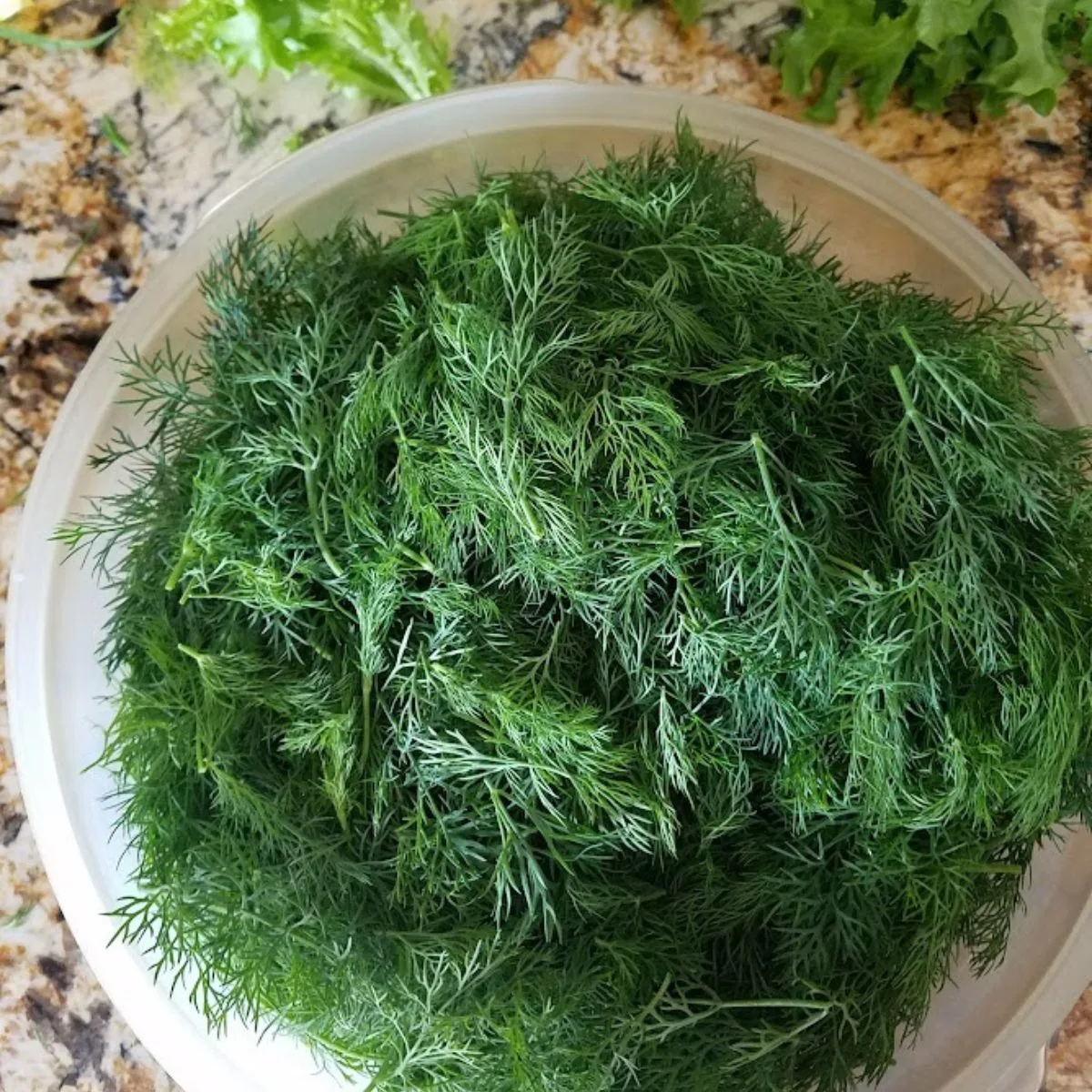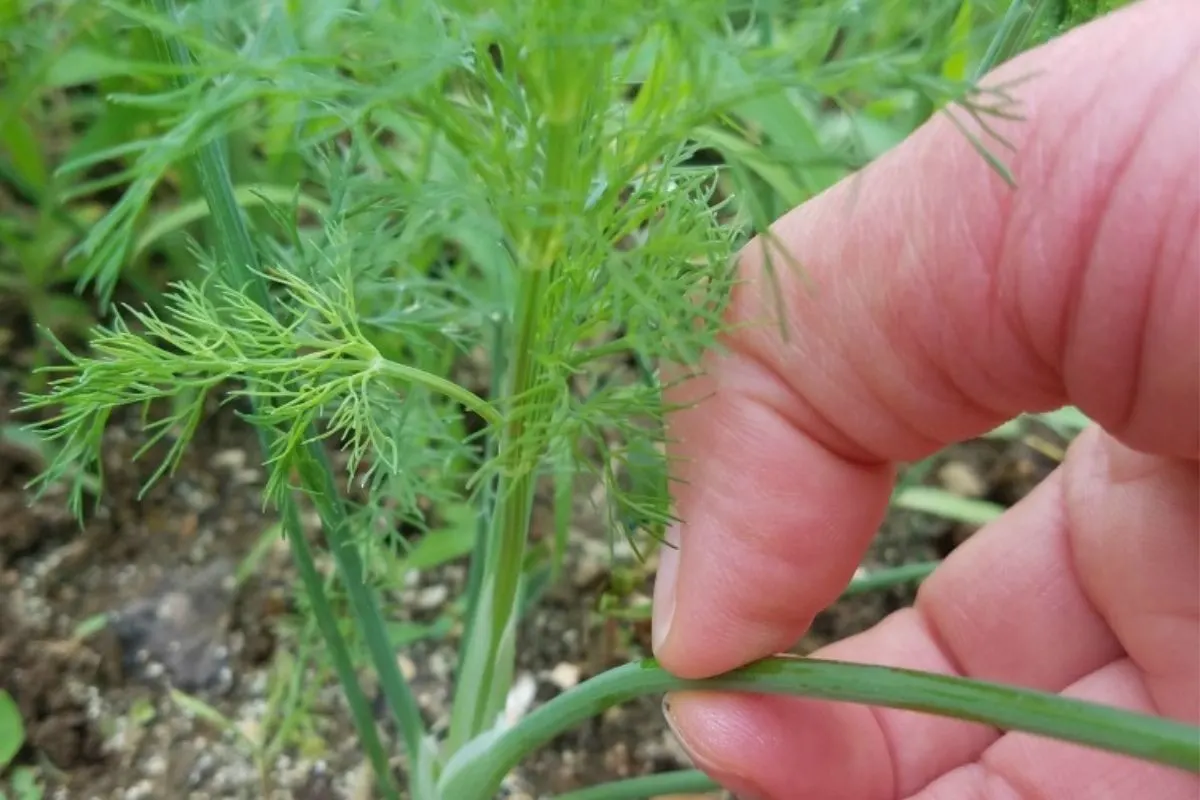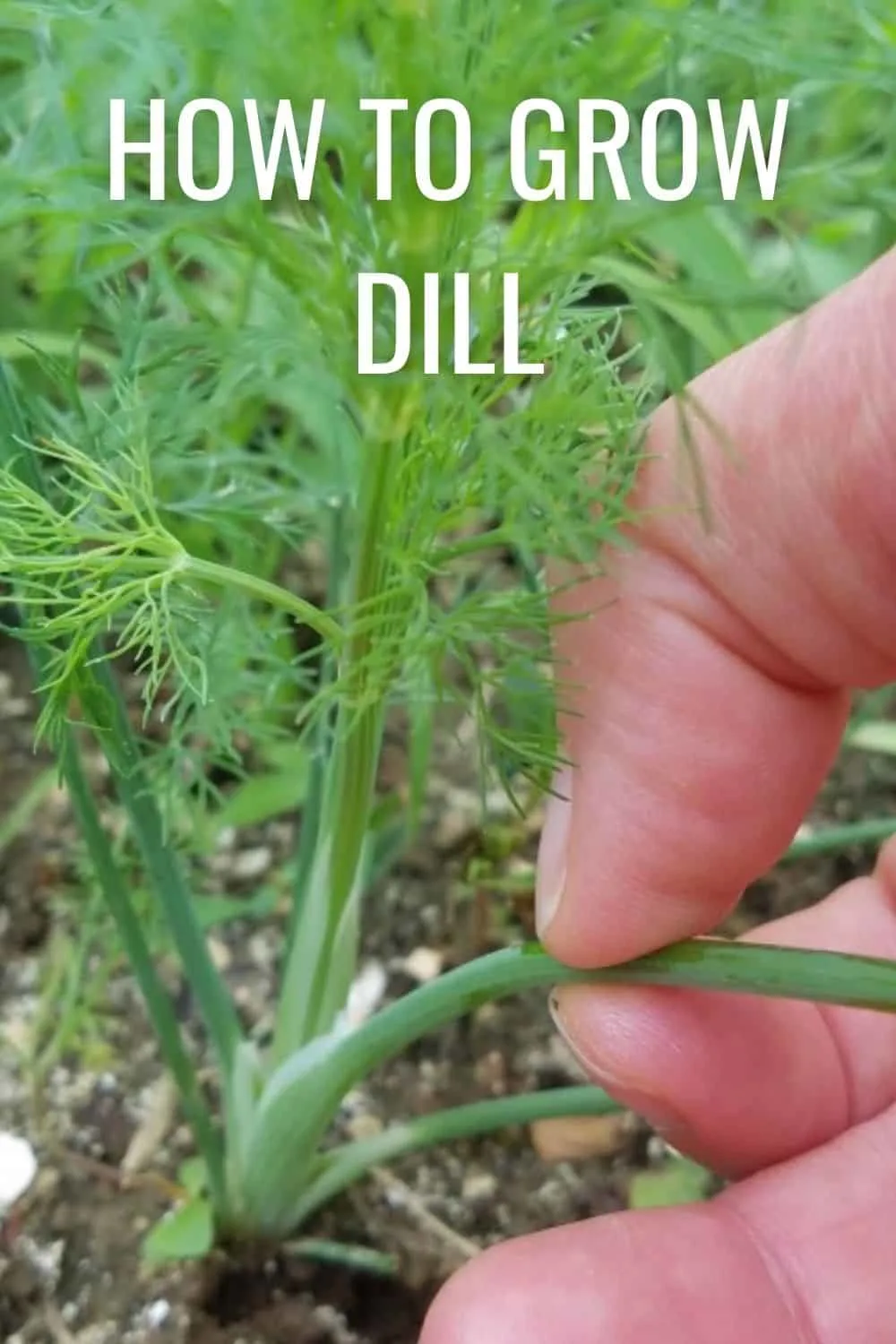We love dill (Anethum graveolens)! Our family uses it pretty much daily: adding it to green salads, flavoring cooked dishes, and mixing it into coleslaw. The aroma is so amazing and delicious that we never get tired of it. We use so much dill that we’d go broke if we had to buy it. Seriously! Here’s how to grow dill so you can enjoy it year-round for free!

Dill plants are easy to grow and have a distinctive flavor and smell. Some people consider dill invasive. Of course, we like it that way. We ran out of the dried dill about a month before the new dill started to grow this year, and we didn’t like it. We will have to grow more this time so we don’t have that same problem.
If you love dill as much as we do – or if you want to try a bit for yourself and see how much you like it – then you’re going to want to learn how to grow your own delicious, healthy dill.
For those wanting to live off the land as much as possible (avid gardeners, homesteaders, or just people who love dill), learning to grow your own can be a very rewarding experience. You can save money by growing your own dill, and it’s a great addition to your kitchen garden. Let’s look at how to do this and get the best results.
History of Dill Cultivation

Dill has many culinary uses, and there are different types of dill. Different parts of the plant can also be used in cooking in different ways. Before diving into how to grow it, let’s look at how this herb became a staple in many people’s diets.
Dill, like chives and parsley, can be used to season foods and is sometimes used as a garnish. Its relatives include caraway, anise, and cilantro.
Dill looks a lot like Fennel, and the two are in the same family, but beyond that, they don’t have much in common.
Is dill an herb or a vegetable?
How did dill get its name?

The genus name Anethum comes from the Greek word meaning “strong smelling”. The English common name refers to its medicinal use. The word “dill” is believed to have Norse origins, and it basically means to lull to sleep or to soothe. Dill was often used to soothe upset stomachs, but the use of dill for food and medicine goes back as far as before the Vikings.
How did it come to be that we use dill in our dishes?
Its exact origin is not known but it is suspected to have been native to the Mediterranean region and western Asia, both places that use dill often in their recipes. In the United States, you can find it in areas that have a similar climate to the Mediterranean, like California, for example.
That said, it will also cultivate and grow in places that aren’t like this at all, such as the northeastern U.S. It’s possible it has evolved over the years and learned to adapt to many more areas and climates. Once mature, it can grow to about 3-4 feet tall and has branching, hollow stems. The leaves are a blue-green color and appear feather-like.
Dill varieties
Like most plants, there are different varieties of dill. While dill is usually used as a culinary herb, both its leaves and its seeds can be used fresh and dried. The yellow flowers are also edible and are sometimes used to garnish salads. Here are the common varieties of dill used for culinary purposes:
- Long Island Mammoth Dill – This large dill variety can grow up to six feet tall in the best conditions, and it has large seed heads that are good for pickling. You can enjoy the leaves fresh or dried.
- Bouquet Dill – This is the most common garden variety and likely what you’ve seen used in kitchens and probably used yourself. It’s very easy to grow and the fresh seeds are good for pickles. It can grow from 2-3 feet tall on average.
- Fernleaf Dill – This one is actually a dwarf variety and it’s a good choice if you need to grow in containers or indoors (not usually recommended but sometimes you have no choice). It grows about 12-18 inches tall.
How To Grow Dill

Now that you know a bit more about Dill, let’s take a look at how you can grow it for yourself. Its needle-like leaves are very fragrant, and the dill plant blooms with tiny yellow flowers. It loves full sun and will even self-seed if left to grow on its own. It’s also a hardy herb, so it can usually hold up to less-than-perfect conditions.
Dill is a biennial herb usually grown as an annual. It thrives in a cooler climate. Try sowing it earlier in the year when the nights are cooler, and the soil is moist.
Dill reseeds itself, so once you plant it you’re all set. You only need to wait for it to grow and then take what you need.
If you are planting dill for the first time, you can do it any time after the last frost. You can plant the seeds in rows 16 to 18 inches apart and about 1/4 inch deep. But we never bothered with that. We just scattered the seeds on one of our raised beds and lightly raked a bit of soil over.
That was probably 10 years ago. Since then, we’ve been enjoying free dill that reseeds itself year after year.
Wonder what other herbs are easy to grow? Try these for some serious flavor 😉
If you’d like fresh dill throughout the summer, plant in stages. Once the first crop goes to seed, the next one will come right up. Plant the first sowing in early spring, as soon as you can work the soil, the second at the end of spring, and the last at the end of summer.

Dill grows well mixed into the herb garden with parsley and chives. We have ours in the raised tomato bed: it helps keep bugs away! Be sure to water regularly and keep the soil moist. You can use fertilizer at the beginning if needed and then again when the plants are about 8 inches tall.
Dill is NOT an indoor herb! If you don’t have an outdoor garden, you can grow some dill in window boxes or in large pots on your patio or balcony.
How to care for dill
Although it looks very delicate, dill is actually a fairly hardy plant that can also withstand a bit of cold. That said, there is still a danger of frost, so the best time to plant is after the chance of frost has passed, which is early spring in most areas. It will grow quickly, and seedlings will appear within about ten days.
It likes rich, acidic soil (pH around 5.8-6.5) that is well-draining.
Be sure to ensure proper spacing when you sow your seeds. For a bushier plant, you can pluck the buds and prune the upper leaves. Remember that everything you take from the dill plant can be used in food, so don’t feel bad about pruning or trimming it back.
How To Harvest Dill

Harvesting dill is as easy as it gets. Pick the tender leaves by pinching at the stem. When you harvest a lot (for drying), you can use a pair of sharp scissors, but for everyday use, pinching them with your nails is the easiest.
Once it goes to seed, harvest the dill seeds too. They are delicious in coleslaw, in savory bread, in soups, and ground up in homemade spices.
The dried stems can be used in pickling cucumbers: YUM!
Of course, leave some dill flowers and seedheads in the garden to seed themselves for the next year: it’s such a nice treat to get fresh dill early in the spring!
Depending on how you plan to use your dill cuttings in the kitchen, they may need to be dried out.
Drying dill

If you plant more than you need for daily use in the summer, fresh dill weed is great when dried for the winter. We pick it regularly (it encourages growth, too) and dry it for use in the winter (we still add it to our salads, even if it’s dried). For the best flavor, it’s important to dry your dill correctly.
To dry it, once we harvest the dill, we wash it, pat it dry, and usually dry it in a dehydrator. Once dried, store in an airtight container and use as needed throughout the year.
Dry dill and dill seeds can then be used in various ways in the kitchen. They will keep for some time, so you don’t have to use them immediately.
If you don’t have a dehydrator, here are a few more methods of preserving herbs.
Dill Pests And Diseases
An important thing to know when gardening with dill is how to protect it from common pests and diseases. Dill isn’t usually bothered by disease, but it’ll occasionally be invaded by aphids. All you need to do is spray the dill plant with a water jet from your hose, and most aphids will fall off. Repeat a few times just to make sure you got them all: they could stick to the wet underside of the leaves.
Learn more about how to get rid of aphids.
It’s important also to know how to look out for signs your dill is not doing well. If you see any of the following, you may have a problem:
- yellowing plants
- weedy-looking dill
- bolting
While they are not overly prone to fungal infections, they can happen, especially if the soil is overwatered. Good drainage can help prevent this. If your plants get fungal disease, they can begin to die.
Pests aren’t a huge problem, but there are some to look out for. Tomato hornworms will attack dill as well. In fact, they are so attracted to it that some people plant dill next to their tomato plants as a deterrent because the hornworms will go to the dill before the tomato plants.
The black swallowtail caterpillars, also known as the parsley worms, love dill too! If you have lots of dill in your garden, let them be: they’ll become gorgeous butterflies. But if you’d rather not share your dill with them just pick them by hand and move them to another part of the garden.
Where can I buy dill seed?
If you’ve decided to plant your own, just sow dill seeds in a proper location and await your bounty. Dill seeds are plentiful at any grocery store or nursery in your area. If you’d rather buy them online so you won’t have to drive, Amazon has several types.
Recipes Made With Dill
We love dill in almost all soups, in a fresh green salad, and as a garnish to many vegetable dishes. It’s delicious with green beans, too.
Here are a few recipes using dill you might want to try.
- Quick And Easy No Cook Refrigerator Dill Pickles
- Cucumber Salad with Sour Cream And Dill
- Dilled Brussels Sprouts
- Herbed Dill Dressing
- Dillie Bread
Final Thoughts on Growing Dill
As you can see, dill is a great choice for garden and kitchen use. Now that you have all of this information about growing dill, you’re ready to start growing your own. If you try it and you’re having some trouble, just be patient and go back to the instructions and try again. Once you get the hang of it and your dill is well-established, it will continue seeding itself, and you’ll have so much wonderful dill to enjoy, the same as my family does.
I hope that learning how to grow dill will encourage you to add it to your daily dishes and experience its wonderful aroma. Are you ready to get started?

Adriana Copaceanu is a passionate nature lover living in the country on her dream property where she grows vegetables, lavender, and wildflowers that she shares with the wildlife they attract. When she's not in the garden, she loves spending time with her chickens and planning her next nature project. Check out her books below:
How to Grow Lavender for Fun and Profit: Lessons Learned from Planting Three Hundred Lavender Plants

8 Best Companion Plants For Squash (And 4 To Avoid)
Sunday 23rd of April 2023
[…] Chec out my guide to growing dill. […]
How To Harvest Dill Without Killing The Plant: Tips & Tricks
Sunday 2nd of April 2023
[…] Learn more about growing dill, including what to plant with dill for a better harvest. […]
Is Dill An Herb Or A Vegetable? Plus 6 Delicious Ways To Use Dill
Sunday 12th of June 2022
[…] To learn more about this interesting herb, be sure to read on as we unpack various components of it. And if you want to grow your own, here’s a guide to growing dill. […]
9 Best Companion Plants For Cauliflower (And 3 To Avoid)
Wednesday 1st of June 2022
[…] Learn more about growing and preserving dill. […]
16 Best Companion Plants For Peppers (And 4 To Avoid)
Friday 18th of March 2022
[…] Dill repels some insect pests, like aphids, while also attracting beneficial insects with its large, flat flower clusters. It may also improve the flavor of peppers and other vegetables. Learn more about growing dill. […]